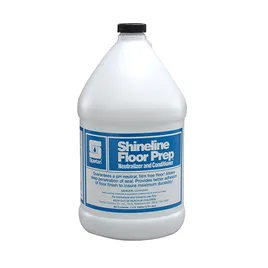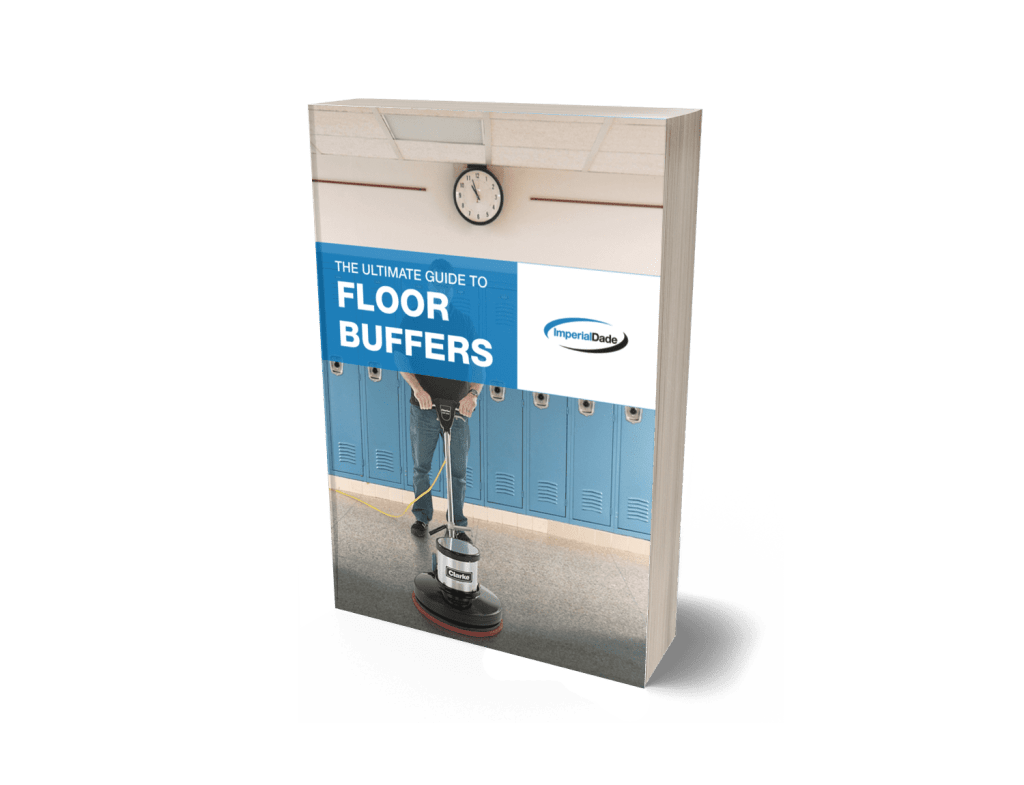A floor buffer is commonly referred to as the “workhorse” of hard floor maintenance.
Floor buffers got this name because of their ability to perform a variety of different floor care procedures, like cleaning, stripping, scrubbing, and buffing.
With a commercial floor buffer, your cleaning staff can avoid having to use different pieces of equipment to achieve clean, shiny floors.
In this article and video, we will review what a floor buffer is and how you can use a floor buffing machine to maintain your commercial hard floors.
What is Floor Buffing?
Floor buffing a commercial hard floor is a maintenance procedure that removes dirt and scuff marks while enhancing the shine of your floor finish.
Floor buffing is performed with a commercial floor buffer.
What is a Floor Buffer?
A commercial floor buffer is a low-speed floor maintenance machine that moves in a side-to-side motion over the top of your floor finish.
Floor buffers operate at speeds of 175-300 RPMs and are paired with different floor pads to complete various floor maintenance procedures.
Depending on the floor pad or brush applied to the machine, buffers can be used to complete a variety of floor cleaning procedures, like cleaning, buffing, scrubbing, or stripping.
What are the different types of floor buffers?
While all floor buffers are cord-electric, features like the cleaning path size, gearbox, and motor will have an effect on how the machine operates.
The most common size floor buffer has a cleaning path of 20-inches, but buffers can have cleaning paths of 13-20 inches. The larger the cleaning path of the floor buffer, the faster your cleaning staff can complete maintenance procedures in your facility.
The type of gearbox that a floor buffer has will provide power and stability to the floor buffer.
Floor buffer gearboxes come in three different types: single, double, and triple planetary. Triple planetary gearboxes provide the best torque for the machine.
When choosing the best floor buffer for your facility, you’ll also want to consider the motor power.
Most floor buffers have a 1.5 horsepower motor, but motors range from 0.5-1.5 hp. The higher the motor horsepower, the more power the machine will have to rotate the floor pad on the machine.
For more information about the types of floor buffers you can choose from, read our full article:
What is the Difference Between Floor Buffers and Burnishers? [VIDEO]
How To Use a Commercial Floor Buffer
To use a commercial floor buffer on your floor, you’ll need:
Equipment:
- Floor Buffer
- Dust Mop/Vacuum
- Wet Vacuum
Supplies:
- Floor Pad/Brush
- Wet Floor Sign
- Floor Cleaner
- Spray Buffing Solution (if necessary)
- Stripping Chemical (if necessary)
To use a floor buffer to maintain your floors, follow these steps below:
- Prep the Area
- Dust Mop or Vacuum the Floor
- Select the Appropriate Cleaning Chemical
- Apply Cleaning Chemical to the Floor
- Apply the Right Floor Pad or Brush
- Lock the Handlebar into the Correct Position
- Begin Buffing
- Use the Wet Vac to Remove Any Slurry
1. Prep The Area
Before using a floor buffer to complete any floor maintenance procedure, you should prep the area.
You’ll need to close the area off to any foot traffic. Next, you should remove any objects that may get in the way of the floor buffer.
2. Dust Mop or Vacuum the Floor
Your floors need to be dust mopped or vacuumed to remove any loose soils, dust, or dirt from your floors.
If you’re using a dust mop to complete floor cleaning, you should make sure to run the dust mop over the entire floor area.
Be careful not to lift the dust mop from the floor. Lifting or shaking the dust mop can cause particles to become airborne.
A vacuum can also be used to remove any dirt, dust, and debris from the surface of your floors.
3. Select the Appropriate Cleaning Chemical
Depending on the cleaning task you will be completing, you may need either a floor cleaner, spray buffing solution, or floor stripper.
How to Select the Right Cleaning Chemical
What’s the Best Chemical for Cleaning Floors?
If you’re cleaning your facility’s waxed hard floors, you should use a neutral floor cleaner.

For grouted or concrete floors, you will need an alkaline floor cleaner.
Pro-Tip: If you’re experiencing harsh winter weather, you should use a floor neutralizer to clean your floors. This will neutralize and remove alkaline soils like ice melt and salt residue that is present on your floors.
What’s the Best Chemical for Stripping Floors?
Chemical floor strippers remove floor finish from your floors.
To properly complete floor stripping, you should apply a floor stripper to your floors and allow it to dwell on the floor for the appropriate amount of time.
What’s the Best Chemical for Buffing Floors?
A spray buffing solution will help restore shine to your floors.
4. Apply Cleaning Chemical to The Floor
Some buffers come with a solution tank on the machine. If your floor buffer has a solution tank, you should properly dilute the cleaning chemical in the tank.
If your floor buffer does not have a solution tank, you should use a pump-up sprayer or mop and bucket to apply floor cleaning chemicals to the floors.
5. Apply the Right Floor Pad or Brush
A floor buffer is used with a floor pad or brush to complete different floor maintenance procedures, like cleaning, scrubbing, buffing, and stripping.
You should be sure to choose the right floor pad for the floor maintenance procedure you’re trying to complete.
Floor buffer pads tend to be darker in color and more aggressive in texture than burnishing pads. The color pad you use on the floor will depend on the cleaning procedure you’re trying to complete.
How to Select the Right Floor Pad
Best Floor Pad For Stripping Floors
A floor buffer can be used to remove wax from your commercial hard floors with a stripping chemical.
To strip your floors using a floor buffer, you will need to use a black or a black high-productivity pad. These are the most aggressive types of floor pads and will be able to remove floor finish from your floors.
Best Floor Pad For Daily Cleaning
A floor buffer can be used to clean your floors. Cleaning will remove light soils and dirt from regular foot traffic in your facility.
To clean your floors using a floor buffer, you should use a red floor pad for everyday cleaning. A red floor pad is aggressive enough to clean your floors without removing layers of floor finish.
Best Floor Pad For Spray Buffing
Spray buffing is able to polish and add shine back to your floors.
To spray buff your commercial hard floors, you should use a white pad on your floor buffer.
Best Floor Pad For Cleaning Grout
A floor buffer can be used with a floor brush to clean grouted floors.
The bristles on the brush will allow your floor buffer to reach into grouted surfaces and clean dirt and soils.
6. Lock The Handle Bar Into The Right Position
After you’ve attached the best floor pad or brush for the application to the machine, you should set the handle to the correct position for proper use.
To have the most control, the handle should be lowered to about the height of your hip. If the handle is too high, it will be very difficult to control and if it’s too low, you may injure your back.
7. Begin Buffing
Once you’ve locked the handle into place properly, you can begin to use the floor buffer.
To properly use the floor buffer, you will need to guide it in even overlapping strokes across the floor.
The cleaning path of the floor buffer is controlled by weight distribution because the wheels of the machine do not touch the floor when in use.
As you’re using the floor buffer to clean or maintain your floors, you should use the handle to guide the machine’s movements.
Applying weight to the front or back of the buffer will steer it to the right or left. Alternating the weight from left to right will move the machine forward and backward.
Final Thoughts
Using a commercial floor buffer to maintain your facility’s floors will help retain the shine of your floor finish and remove dirt, soils, and scuff marks. You can perform a variety of floor cleaning and maintenance procedures with a floor buffer, like cleaning, stripping, and spray buffing.
Making sure that your floor buffer is being used properly is key to getting the most out of your floor cleaning equipment.
Imperial Dade locations have a wide range of floor cleaning machines, including floor buffers, that can help you and your cleaning staff maintain your floor finish.
If you’re located in the United States, Puerto Rico, the Caribbean, or Canada contact a specialist today for more information about how a floor buffer can help enhance your floor cleaning routine.
Check Out These Related Articles:
- What is the Difference Between Floor Buffers and Burnishers? [VIDEO]
- What is the Best Floor Pad for your Buffer or Burnisher? [VIDEO]
- What’s The Best Floor Pad for VCT (Vinyl Composition Tile)?
- 4 Ways To Keep Your Floors Looking Their Best This Winter
- How to Choose the Best Floor Finish For Your Facility: Types & Considerations

